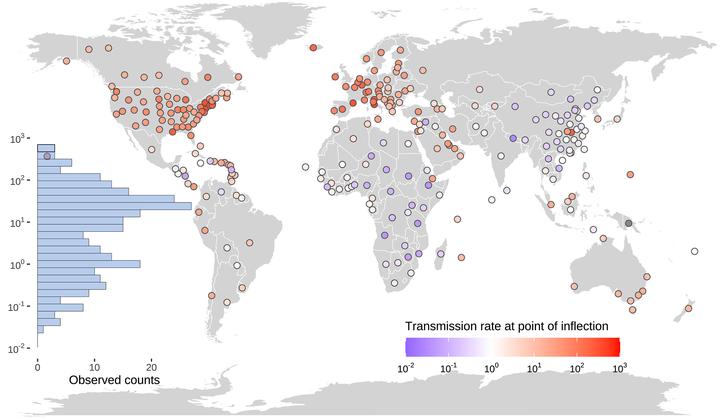Geohealth: A Warm Summer is Unlikely to Stop Transmission of COVID‐19 Naturally
 Graphic Abstract
Graphic Abstract
摘要
The outbreak of coronavirus disease 2019 (COVID‐19) showed various transmission rate (Rt) across different regions. The determination of the factors affecting transmission rate is urgent and crucial to combat COVID‐19. Here we explored variation of Rt between 277 regions across the globe and the associated potential socioeconomic, demographic, and environmental factors. At global scale, the Rt started to decrease approximately 2 weeks after policy interventions initiated. This lag from the date of policy interventions initiation to the date when Rt started to decrease ranges from 9 to 19 days, largest in Europe and North America. We find that proportion of elderly people or life expectancy can explain ~50% of variation in transmission rate across the 277 regions. The transmission rate at the point of inflection (RI) increases by 29.4% (25.2–34.0%) for 1% uptick in the proportion of people aged above 65, indicating that elderly people face ~2.5 times higher infection risk than younger people. Air temperature is negatively correlated with transmission rate, which is mainly attributed to collinearities between air temperature and demographic factors. Our model predicted that temperature sensitivity of RI is only −2.7% (−5.2–0%) per degree Celsius after excluding collinearities between air temperature and demographic factors. This low temperature sensitivity of RI suggests that a warm summer is unlikely to impede the spread of COVID‐19 naturally.
Highlights
- Timeline of COVID-19 outbreak in277 regions across the globe was summarized
- Proportion of elderly people or lifeexpectancy can explain 50% ofvariation in transmission rate of COVID-19 across the 277 regions
- Temperature sensitivity oftransmission rate at inflection pointis estimated to be −2.7% (−5.2% to0%) per degree Celsius